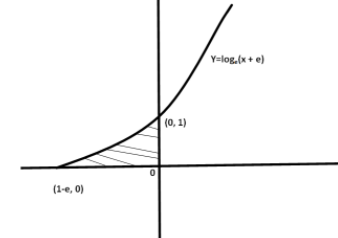
The area enclosed between the curve $y={{\log }_{e}}\left( x+e \right)$ and the coordinate axes is:
A) 3
B) 4
C) 1
D) 2
Answer
563.7k+ views
Hint:
Here we have to find the area enclosed by the given curve and the coordinate axes. For that, we will trace the graph for the given curve and then we will find the points where the curve has cut the x and y axes. Then, we will find the area by integrating the given curve between the proper ranges.
Complete step by step solution:
The given curve is $y={{\log }_{e}}\left( x+e \right)$
First we will draw the curve on the coordinate axes.
At $x=0;y=1$
At $x=1-e;y=0$
We have got the points where the curve will cut the x-axis and y-axis. We will draw the curve using these points.

Now, we will calculate the shaded area by integrating it from $x=1-e$ to $x=0$
Area of the shaded region $=\int\limits_{1-e}^{0}{{{\log }_{e}}\left( x+e \right)}dx$
We will integrate by substitution method.
Let $x+e=t$
Differentiating both sides with respect to x, we get
$dx=dt$
At $x=1-e;t=1\text{ }\!\!\And\!\!\text{ at }x=0;t=e$
Therefore,
Area of the shaded region $=\int\limits_{1}^{e}{{{\log }_{e}}\left( t \right)}dt$
Now, we will integrate it.
Area of the shaded region $=\left[ t\log {{t}_{e}}-t \right]_{1}^{e}$
On simplifying it further, we get
Area of the shaded region $=\left[ e\log {{e}_{e}}-e-0-1 \right]$
Now, will put the value of here
Area of the shaded region $=\left[ e-e-0-1 \right]$ {As$\log {{e}_{e}}=1$ }
Now, we will subtract the similar terms.
Area of the shaded region $=1\text{sq}\text{.unit}$
Therefore,
Area enclosed between the curve $y={{\log }_{e}}\left( x+e \right)$ and the coordinate axes is 1sq.unit.
Thus, the correct option is C.
Note:
The important terms that we need to know are:-
1) An integration of any function f(x) is a method of finding a function h(x) whose derivative i.e. $\dfrac{dh(x)}{dx}$ is equal to the given function f(x).
2) A curve is defined as a line which is drawn smoothly in a plane and which doesn’t bend or turn anywhere in a plane.
Here we have to find the area enclosed by the given curve and the coordinate axes. For that, we will trace the graph for the given curve and then we will find the points where the curve has cut the x and y axes. Then, we will find the area by integrating the given curve between the proper ranges.
Complete step by step solution:
The given curve is $y={{\log }_{e}}\left( x+e \right)$
First we will draw the curve on the coordinate axes.
At $x=0;y=1$
At $x=1-e;y=0$
We have got the points where the curve will cut the x-axis and y-axis. We will draw the curve using these points.

Now, we will calculate the shaded area by integrating it from $x=1-e$ to $x=0$
Area of the shaded region $=\int\limits_{1-e}^{0}{{{\log }_{e}}\left( x+e \right)}dx$
We will integrate by substitution method.
Let $x+e=t$
Differentiating both sides with respect to x, we get
$dx=dt$
At $x=1-e;t=1\text{ }\!\!\And\!\!\text{ at }x=0;t=e$
Therefore,
Area of the shaded region $=\int\limits_{1}^{e}{{{\log }_{e}}\left( t \right)}dt$
Now, we will integrate it.
Area of the shaded region $=\left[ t\log {{t}_{e}}-t \right]_{1}^{e}$
On simplifying it further, we get
Area of the shaded region $=\left[ e\log {{e}_{e}}-e-0-1 \right]$
Now, will put the value of here
Area of the shaded region $=\left[ e-e-0-1 \right]$ {As$\log {{e}_{e}}=1$ }
Now, we will subtract the similar terms.
Area of the shaded region $=1\text{sq}\text{.unit}$
Therefore,
Area enclosed between the curve $y={{\log }_{e}}\left( x+e \right)$ and the coordinate axes is 1sq.unit.
Thus, the correct option is C.
Note:
The important terms that we need to know are:-
1) An integration of any function f(x) is a method of finding a function h(x) whose derivative i.e. $\dfrac{dh(x)}{dx}$ is equal to the given function f(x).
2) A curve is defined as a line which is drawn smoothly in a plane and which doesn’t bend or turn anywhere in a plane.
Recently Updated Pages
A man running at a speed 5 ms is viewed in the side class 12 physics CBSE

The number of solutions in x in 02pi for which sqrt class 12 maths CBSE

State and explain Hardy Weinbergs Principle class 12 biology CBSE

Write any two methods of preparation of phenol Give class 12 chemistry CBSE

Which of the following statements is wrong a Amnion class 12 biology CBSE

Differentiate between action potential and resting class 12 biology CBSE

Trending doubts
What are the major means of transport Explain each class 12 social science CBSE

Which are the Top 10 Largest Countries of the World?

Draw a labelled sketch of the human eye class 12 physics CBSE

How much time does it take to bleed after eating p class 12 biology CBSE

Explain sex determination in humans with line diag class 12 biology CBSE

Explain sex determination in humans with the help of class 12 biology CBSE




